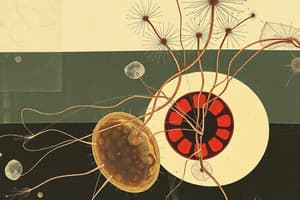Podcast
Questions and Answers
What is the difference between endocytosis and exocytosis?
What is the difference between endocytosis and exocytosis?
Endocytosis is a type of active transport that moves particles into a cell, while exocytosis is the process where cells 'throw out' material.
What is the difference between phagocytosis and pinocytosis?
What is the difference between phagocytosis and pinocytosis?
Phagocytosis is the process of 'cell eating' where large particles are taken in, while pinocytosis is 'cell drinking' where small molecules and fluids are absorbed.
What is receptor-mediated endocytosis?
What is receptor-mediated endocytosis?
It is a process where receptor proteins on the cell surface capture specific target molecules.
What is the difference between kinetic energy and potential energy?
What is the difference between kinetic energy and potential energy?
Is ATP (chemical energy) a form of kinetic energy or potential energy?
Is ATP (chemical energy) a form of kinetic energy or potential energy?
What are the first and second laws of thermodynamics?
What are the first and second laws of thermodynamics?
What is entropy and how does it relate to the laws of thermodynamics?
What is entropy and how does it relate to the laws of thermodynamics?
What is the difference between endergonic and exergonic reactions?
What is the difference between endergonic and exergonic reactions?
How do cells use ATP to perform certain functions?
How do cells use ATP to perform certain functions?
What is a substrate and an active site?
What is a substrate and an active site?
What factors affect enzyme functions?
What factors affect enzyme functions?
What is the difference between a competitive and noncompetitive inhibitor?
What is the difference between a competitive and noncompetitive inhibitor?
What is feedback inhibition?
What is feedback inhibition?
What is cellular respiration?
What is cellular respiration?
What are the reactants and products of cellular respiration?
What are the reactants and products of cellular respiration?
What are kilocalories?
What are kilocalories?
What is the difference between oxidation and reduction?
What is the difference between oxidation and reduction?
What is the function of a dehydrogenase?
What is the function of a dehydrogenase?
What happens to electron energy as electrons are transferred from one molecule to another?
What happens to electron energy as electrons are transferred from one molecule to another?
What is the difference between oxidative phosphorylation and substrate-level phosphorylation?
What is the difference between oxidative phosphorylation and substrate-level phosphorylation?
How are chemiosmosis and ATP synthase related?
How are chemiosmosis and ATP synthase related?
Where do glycolysis, pyruvate oxidation, the citric acid cycle, and oxidative phosphorylation occur in a cell?
Where do glycolysis, pyruvate oxidation, the citric acid cycle, and oxidative phosphorylation occur in a cell?
What are the reactants and products of glycolysis?
What are the reactants and products of glycolysis?
What is photorespiration?
What is photorespiration?
How do C4 and CAM plants reduce photorespiration?
How do C4 and CAM plants reduce photorespiration?
Flashcards are hidden until you start studying
Study Notes
Transport Mechanisms
- Endocytosis: Active transport process allowing cells to engulf particles. Types include phagocytosis (cell eating), pinocytosis (cell drinking), and receptor-mediated endocytosis (specific target molecules captured by receptors).
- Exocytosis: Process where cells expel materials through vesicles fusing with the plasma membrane.
Energy Types
- Kinetic Energy: Energy of motion; exemplified by moving objects such as a walking person or a ball in flight.
- Potential Energy: Stored energy due to position; for example, a ball held high by a demolition machine.
ATP Functionality
- ATP: Stores potential energy in chemical bonds; releases energy for cellular functions when these bonds break, acting as both a potential energy repository and a kinetic energy source.
Laws of Thermodynamics
- First Law: Energy cannot be created or destroyed, only transformed.
- Second Law: Energy transformations increase entropy in a closed system.
Reactions
- Endergonic Reactions: Require energy input.
- Exergonic Reactions: Release energy.
Enzymatic Activity
- Enzymes: Function is affected by temperature, pH, cofactors/coenzymes, and inhibitors.
- Inhibitors:
- Competitive: Mimic the substrate, blocking active site.
- Noncompetitive: Bind elsewhere, altering the enzyme's effectiveness.
Cellular Respiration
- Definition: Process breaking down glucose in the presence of oxygen to produce ATP.
- Reactants: Glucose and oxygen.
- Products: Carbon dioxide, water, ATP, and heat.
Photosynthesis
- Reactants: 6CO2 and 6H2O.
- Products: C6H12O6 (glucose) and 6O2.
- Oxygen Production: Water is oxidized to O2 during photosynthesis in the thylakoid membrane.
Chloroplast Structures
- Mesophyll Cells: Contain photosynthetic cells.
- Stroma: Thick fluid surrounding grana in chloroplasts.
- Grana: Stacks of thylakoids where photosynthesis takes place.
- Thylakoid Membrane: Site for converting light energy into chemical energy.
Photosystems
- Photosystem I: Absorbs light at 700 nm, produces NADPH.
- Photosystem II: Absorbs light at 680 nm, produces ATP and replaces lost electrons by oxidizing water.
Calvin Cycle
- Phases:
- Carbon fixation: CO2 combines with RuBP.
- Reduction: 3-PGA converts into G3P using ATP and NADPH.
- Exit: Some G3P leaves for glucose synthesis.
- Regeneration: Remaining G3P reforms RuBP using ATP.
Photorespiration
- Process where oxygen is taken up and carbon dioxide released, leading to inefficient photosynthesis.
C4 and CAM Plants
- C4 Plants: Separate carbon fixation and the Calvin cycle spatially in different cell types to reduce photorespiration.
- CAM Plants: Conduct carbon fixation and the Calvin cycle at different times to minimize photorespiration.
Studying That Suits You
Use AI to generate personalized quizzes and flashcards to suit your learning preferences.




